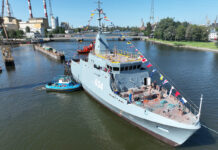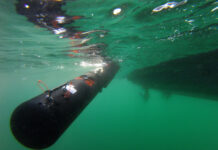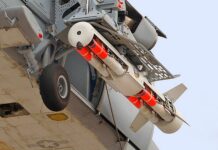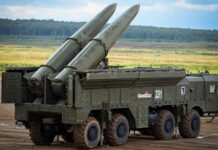The Russian Navy’s shipbuilding plan for this year is being carried out on schedule with plans to commission up to 40 ships and vessels, including two Project 12700 Mine Countermeasures (MCM) ships joining the four existing vessels. Four more MCM ships are being manufactured by the Sredne-Nevsky Shipbuilding Plant (part of the United Shipbuilding Corporation). At the end of April, the fifth Project 12700 MCM PYOTR ILLYICHEV was launched in St. Petersburg, the Russian MoD reported. This ship, and another named GEORGI KURBATOV, will join the Russian Navy before end of 2021.
In his speech to shipbuilders at the launching ceremony, the Commander-in-Chief of the Russian Navy, Admiral Nikolai Evmenov, noted that “the ships of the project” have a large modernisation potential and thus an order for series can be further extended.
Project 12700 was developed by the Almaz Central Marine Design Bureau (also part of the United Shipbuilding Corporation) for the Russian Navy. These ships belong to a new generation of mine-sweeping forces and are designed to combat sea mines, which the new MCM ships can detect both in the water and in sea soil, without entering the danger zone. To combat mines, the ships can use various types of trawls, as well as remote-controlled and autonomous Unmanned Underwater Vehicles.
Russian MCM Features
When building such ships at the Sredne-Nevsky shipyard, the latest Russian technologies are used. They have a hull made of monolithic fibreglass, formed by vacuum infusion. The advantage of such a hull is its high strength and “invisibility” for magnetic mines, which ensures the mine resistance of the ship. Such a hull offers a longer service life (over 30 years) than a hull made of low-magnetic steel and is much lighter than its counterparts. The ships have unique station-keeping capabilities in high sea states and can detect and neutralise silted mines in Sea State 5.
The necessary precision navigation equipment is available on board the ship for effective countermine operations. The ship uses large-diametre low-noise propellers placed in noise-reducing pods to protect against acoustic mines. Availability of the Diez automated system of anti-mine warfare enables it to direct the activity of a group of mine countermeasures ships. The vessel offers high manoeuvrability through the use of an effective thruster system.
The Alexandrite-E MCM export version has strong potential. In particular, Russia is targeting a tender for 12 MCM ships for the Indian Navy. According to Indian magazine ‘The Week’, the Indian Navy is facing a critical requirement for MCM vessels, as it only operates two minesweepers to protect its sea routes and ports.
Yury Laskin













